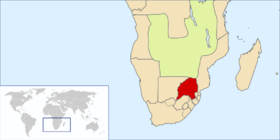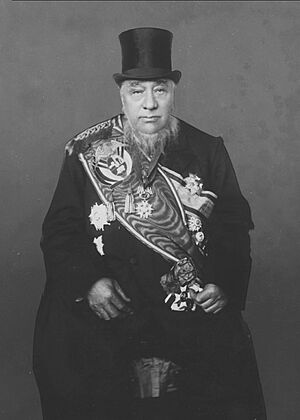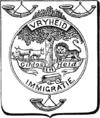South African Republic facts for kids
Quick facts for kids
South African Republic
Zuid-Afrikaansche Republiek
|
|||||||||||||||||||||
|---|---|---|---|---|---|---|---|---|---|---|---|---|---|---|---|---|---|---|---|---|---|
| 1852–1902, 1914–1915 | |||||||||||||||||||||
|
Anthem: "Volkslied van Transvaal"
|
|||||||||||||||||||||
 |
|||||||||||||||||||||
| Capital | Pretoria | ||||||||||||||||||||
|
|||||||||||||||||||||
| National languages | Dutch Afrikaans |
||||||||||||||||||||
|
• Common languages
|
English, Afrikaans, Pedi, and other Bantu languages | ||||||||||||||||||||
| Religion | Dutch Reformed Church | ||||||||||||||||||||
| Demonym(s) | Transvaaler South African |
||||||||||||||||||||
| Government | Parliamentary republic | ||||||||||||||||||||
| Executive Council | |||||||||||||||||||||
|
• 1857–1860
|
Marthinus W. Pretorius | ||||||||||||||||||||
|
• 1860–1862
|
Stephanus Schoeman | ||||||||||||||||||||
|
• 1862–1864
|
W. C. J. van Rensburg | ||||||||||||||||||||
| State President | |||||||||||||||||||||
|
• 1866–1871
|
Marthinus W. Pretorius | ||||||||||||||||||||
|
• 1872–1877
|
Thomas F. Burgers | ||||||||||||||||||||
|
• 1883–1902
|
Paul Kruger | ||||||||||||||||||||
|
• 1900–1902 (acting)
|
Schalk Willem Burger | ||||||||||||||||||||
| State Secretary | |||||||||||||||||||||
|
• 1880–1888
|
Willem Eduard Bok | ||||||||||||||||||||
|
• 1888–1898
|
Willem Johannes Leyds | ||||||||||||||||||||
|
• 1898–1902
|
Francis William Reitz | ||||||||||||||||||||
| Legislature | Volksraad | ||||||||||||||||||||
| Establishment | |||||||||||||||||||||
|
• Sand River Convention
|
17 January 1852 | ||||||||||||||||||||
| 7 October 1862 | |||||||||||||||||||||
|
• Transvaal Colony
|
12 April 1877 | ||||||||||||||||||||
| 12 December 1880 | |||||||||||||||||||||
| 3 August 1881 | |||||||||||||||||||||
|
• London Convention
|
27 February 1884 | ||||||||||||||||||||
| 11 October 1899 | |||||||||||||||||||||
| 31 May 1902 | |||||||||||||||||||||
|
• Maritz rebellion
|
Sep 1914 – Feb 1915 | ||||||||||||||||||||
| Area | |||||||||||||||||||||
|
• Total
|
191,789 km2 (74,050 sq mi) | ||||||||||||||||||||
| Population | |||||||||||||||||||||
|
• 1897
|
867,941 | ||||||||||||||||||||
| Currency | South African pound | ||||||||||||||||||||
|
|||||||||||||||||||||
| Today part of | |||||||||||||||||||||
The South African Republic (ZAR), also known as the Transvaal Republic, was an independent country in Southern Africa. It existed from 1852 to 1902. The ZAR was founded by the Boers, who were Dutch-speaking settlers. It became part of the British Empire after the Second Boer War.
The ZAR was created after the Sand River Convention in 1852. In this agreement, the British government recognized the independence of the Boers living north of the Vaal River. However, problems soon arose between the ZAR and Britain. This led to the First Boer War. The Boers won this war, confirming their independence.
But tensions continued, leading to the Second Boer War in 1899. British forces quickly took over the ZAR. Many Boer fighters refused to give up. The British commander, Lord Kitchener, ordered a "scorched-earth policy". This meant destroying farms and resources to weaken the Boers.
The war ended with the Treaty of Vereeniging in 1902. The ZAR then became the Transvaal Colony. Later, it joined the Union of South Africa. During World War I, some Boers tried to bring back the republic in the Maritz rebellion, but it failed. Today, the land that was once the ZAR is part of modern South Africa. It includes provinces like Gauteng, Limpopo, Mpumalanga, and North West.
Contents
Understanding the South African Republic
What's in a Name? The ZAR and Transvaal
The country was officially called the Zuid Afrikaansche Republiek (South African Republic). People often called it Transvaal. This name meant "beyond the Vaal River". The British preferred the name "Transvaal State".
After the First Boer War, the British tried to make the ZAR use the name "Transvaal State". But in 1884, a new agreement, the London Convention, allowed the ZAR to go back to its original name.
During the Second Boer War, in 1900, the British declared the country's name changed to "the Transvaal". This happened while the ZAR was still fighting for its independence. After the war ended in 1902, the ZAR became the Transvaal Colony. In 1910, it became the Transvaal Province within the Union of South Africa. The name "Transvaal" was finally changed in 1994. The area was then divided into new provinces.
How the Republic Began
The Boer republics started when the British took over the Cape Colony from the Dutch in 1806. The British wanted to control sea routes to India. Many Boers were unhappy with British rule. They decided to leave the colony. This journey was called the Great Trek. They moved inland and became farmers.
The South African Republic officially began on January 17, 1852. This was when the British signed the Sand River Convention. This treaty recognized the independence of about 40,000 Boers. They lived north of the Vaal River.
The first president of the ZAR was Marthinus Wessel Pretorius. He was elected in 1857. His father, Andries Pretorius, was a famous Boer leader. He led the Boers to victory at the Battle of Blood River. The capital city was first Potchefstroom. It later moved to Pretoria. The country's parliament was called the Volksraad. It had 24 members.
British Takeover and the First Boer War
In the 1870s, the British wanted to unite South Africa. This was to control the Boers and protect their colonies. The British also worried about the Boers getting access to the sea. This would make them more independent. They also worried about other European countries getting involved.
Another big concern was how the Boers treated local African kingdoms. The British feared these conflicts could spread. If the Boers won, more refugees might flee into British areas. If African groups won, other tribes might gain confidence to fight the British.
In 1876, a war broke out between the Boers and the Bapedi chief Sekhukhune. The Boers struggled in this war. This made the ZAR seem weak and in financial trouble. This gave the British an excuse to step in. Sir Theophilus Shepstone was sent to annex the Transvaal. He believed British control was the only way to bring stability.
On April 12, 1877, the British officially took over the South African Republic. They said the country was "unstable" and "bankrupt". The ZAR leaders protested this, but they did not declare war right away.
However, on December 13, 1880, Boer leaders like Paul Kruger, Piet Joubert, and Marthinus Wessel Pretorius took charge. They declared Heidelberg their government seat. They raised their flag, the Vierkleur. This led to the First Boer War. The Boers fought bravely and defeated the British in several battles. At the Battle of Majuba Hill, the British General Sir George Pomeroy Colley was killed.
British Prime Minister William Gladstone decided to make peace. The Pretoria Convention was signed in 1881. This treaty gave the ZAR back some self-rule. The British called the area "Transvaal Territory". But the ZAR's parliament believed the old South African Republic was restored.
Full Independence and Growth
The ZAR became fully independent on February 27, 1884. This happened when the London Convention was signed. After this, the country made its own agreements with other nations.
In 1885, large amounts of gold were found in the Witwatersrand area. This discovery completely changed the ZAR's economy. It had been a poor farming country. Now, the city of Johannesburg grew rapidly as a gold mining town. Within 10 years, it became the largest city in Southern Africa.
The gold wealth allowed the ZAR to build a railway network. The Netherlands-South African Railway Company built lines, including one from Pretoria to Lourenço Marques (now Maputo) in Portuguese East Africa. This railway was very important to President Paul Kruger. It gave the ZAR access to a harbor not controlled by the British. This was key for the country's long-term survival.
The Second Boer War and the End of the Republic

The British tried to take over the ZAR again in December 1895 with the Jameson Raid. This raid failed. But British forces continued to gather troops and resources near the ZAR's borders. They demanded voting rights for the many foreign nationals, mostly British, who had come for the gold.
President Kruger refused these demands. He asked the British to remove their troops. When they refused, Kruger declared war against Britain. This started the Second Boer War in October 1899. Britain received help from its colonies like Australia and Canada.
The British used concentration camps during this war. Women and children were held in these camps. Conditions were very bad, and many thousands died from lack of food and medical care.
The war ended with the Treaty of Vereeniging on May 31, 1902. This treaty officially ended the South African Republic. It became part of the British Empire. The Boers were promised some self-government later. This happened in 1906 and 1907. In 1910, the Union of South Africa was formed.
The Maritz Rebellion
A final attempt to bring back the South African Republic happened during World War I. This was the Maritz rebellion in 1914. It was led by some Boers who wanted to re-establish the republic. They even allied with Germany, which was at war with Britain. However, the rebellion failed by 1915. The leaders faced heavy fines and prison time.
Laws and People
Government and Legal System
The ZAR's constitution was quite advanced for its time. It separated the political leaders from government workers. The legal system had higher and lower courts. It also used a jury system. Laws were enforced by the South African Republic Police (ZARP). These police were divided into mounted (on horseback) and foot police.
The ZAR also had local city governments. Courts like the Witwatersrand District Court and the High Court of Transvaal were established.
Population and Demographics
In 1897, the ZAR's official records showed that there were 245,397 white people. The total black population was 622,544.
| District | White | ||
|---|---|---|---|
| Males | Females | Total | |
| Barberton | 3,500 | 2,900 | 6,400 |
| Bloemhof | 2,000 | 1,600 | 3,600 |
| Boksburg | 3,200 | 2,100 | 5,300 |
| Carolina | 2,500 | 1,200 | 3,700 |
| Ermelo | 2,700 | 1,850 | 4,650 |
| Heidelberg | 5,770 | 2,050 | 7,820 |
| Johannesburg (town) | 32,387 | 18,520 | 50,907 |
| Johannesburg (neighbourhood) | 4,000 | 2,500 | 6,500 |
| Krugersdorp | 10,600 | 9,950 | 20,450 |
| Lichtenburg | 3,600 | 3,000 | 6,500 |
| Lydenburg | 1,600 | 1,250 | 2,750 |
| Marico | 3,600 | 3,000 | 6,500 |
| Middelburg | 5,500 | 4,000 | 9,500 |
| Piet-Retief | 600 | 660 | 1,160 |
| Potchefstroom | 12,600 | 12,300 | 24,900 |
| Pretoria | 15,700 | 14,600 | 30,300 |
| Rustenburg | 5,600 | 5,000 | 10,600 |
| Standerton | 3,600 | 3,750 | 7,550 |
| Utrecht | 1,750 | 1,100 | 2,860 |
| Vrijheid | 2,640 | 2,520 | 5,160 |
| Wakkerstroom | 6,000 | 6,700 | 11,700 |
| Waterberg | 2,600 | 2,300 | 4,900 |
| Wolmaranstad | 1,600 | 1,600 | 3,100 |
| Zoutpansberg | 4,500 | 4,200 | 8,700 |
| Total | 137,947 | 107,450 | 245,397 |
Religion and Citizenship
At first, the ZAR's constitution said that citizens had to be members of the Dutch Reformed Church. Later, this was changed to allow other Dutch Christian churches. The Bible was often used to help interpret laws and agreements.
Citizenship in the ZAR was based on being born there or becoming naturalized. The voting age was 16. To become a citizen, foreigners had to take an oath. This oath meant giving up loyalty to their old country. A law from 1855 said that only white people could be citizens and own land. The constitution stated that there would be no equality between non-white and white inhabitants in the church or state.
When gold was discovered, many people from Asia came to Johannesburg. The ZAR passed a law to control Asian immigration. This law said that Asians could not own land. They also had to register with the government and pay a fee. They were limited to living in certain areas. Indian merchants, who were seen as "Arabs", asked the British government for help. After British pressure, the law was changed. Asians could then own property (but not land) and the fee was lowered.
To be a citizen, white foreigners had to live in the ZAR for two years. They also had to be of good character and be part of a Dutch Reformed Church. In 1893, the constitution was changed. Now, two-thirds of the Volksraad had to agree to changes in citizenship law. This also changed voting rules. Citizens born in the ZAR or who got voting rights before 1890 could vote in all elections. Those who became citizens after 1890 could vote in most elections, but not for the main Volksraad.
Military and Defense
The ZAR's military was based on the kommando system. This meant that all able-bodied male citizens (called burghers) could be called to serve in the military. They wore no uniforms and had no medals. Their officers were elected by the local burghers.
The main military officer was the field cornet. They handled both military and administrative duties. They collected taxes, took censuses, trained men, and gathered weapons. They also kept state power over local black populations. The overall commander was the commandant-general. They bought weapons and controlled the ivory trade, which was important for the economy.
The ZAR also had a professional military unit called the Staatsartillerie (State Artillery). In 1899, it had 314 men. They used modern Krupp artillery guns from Germany. The ZARP (South African Republic Police) was a paramilitary force. In 1899, about 30,000 men could be called up for military service.
Language and Culture
The main language spoken and written in the ZAR was a form of Dutch. It was called Hooghollands. In 1884, the Volksraad noticed that some schools were using "impure Dutch". This was an early form of Afrikaans. The Volksraad then made a law to ensure only Dutch was used.
In 1888, Dutch was declared the only official language. It was used in courts, schools, trade, and general life. All other languages were called "foreign". Using a foreign language could lead to a fine.
The discovery of gold in 1885 brought many foreigners to the ZAR. By 1896, Dutch was still the government language. But in many markets, shops, and homes, English was spoken.
Images for kids
-
Piet Cronjé's followers delivering up their rifles
See also
 In Spanish: República Sudafricana para niños
In Spanish: República Sudafricana para niños







